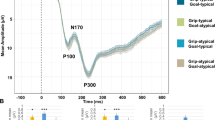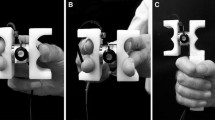Abstract
It has been suggested that, relative to natural objects, man-made object representations in the brain are more specifically defined by functional properties that reflect how an object is used and/or what it is used for (Warrington and Shallice 1984). We recorded 123-channel event-related potentials (ERP) in healthy participants during a mental rotation task involving a manipulable (hammer) and a non-manipulable (church) object. Both stimuli had standard and mirror-image versions rotated in four different orientations, resulting for the manipulable object in some natural and some awkward grips. Using spatial cluster analysis, time periods were determined during which the ERP maps differed between stimulus conditions. Specific maps appeared for natural versus awkward grips with the manipulable object at a very early stage (60–116 ms) as well as during a later stage (180–280 ms). Source estimations derived from the topographic data indicated that during the second time window the left motor cortex was significantly activated in the case of natural grips. We argue that the motor programs that are semantically associated with the object are automatically activated when it is presented in graspable orientations.





Similar content being viewed by others
References
Binkofski F, Buccino G, Stephan KM, Rizzolatti G, Seitz RJ, Freund HJ (1999) A parieto-premotor network for object manipulation: evidence from neuroimaging. Exp Brain Res 128:210–213
Brandeis D, Lehmann D (1986) Event-related potentials of the brain and cognitive processes: approaches and applications. Neuropsychologia 24:151–168
Bullier J (2001) Integrated model of visual processing. Brain Res Rev 36:96–107
Carpenter PA, Just MA, Keller TA, Eddy W, Thulborn K (1999) Graded functional activation in the visuospatial system with the amount of task demand. J Cogn Neurosci 11:9–24
Chao LL, Martin A (2000) Representation of manipulable man-made objects in the dorsal stream. Neuroimage 12:478–484
Chao LL, Haxby JV, Martin A (1999) Attribute-based neural substrates in posterior temporal cortex for perceiving and knowing about objects. Nat Neurosci 2:913–919
Cooper LA, Shepard RN (1973) Chronometric studies of the rotation of mental images. In: Chase WG (ed) Visual information processing. Academic Press, New York
Craighero L, Fadiga L, Umilta C, Rizzolatti G (1996) Evidence for visuomotor priming effect. Neuroreport 8:347–349
De’Sperati C, Stucchi N (1997) Recognizing the motion of a graspable object is guided by handedness. Neuroreport 8:2761–2765
Di Russo F, Martinez A, Sereno MI, Pitzalis S, Hillyard SA (2002) Cortical sources of the early components of the visual evoked potential. Hum Brain Mapp 15:95–111
Gibson JJ (1979) The ecological approach to perception. Houghton Mifflin, Boston
Grafton ST, Fagg AH, Woods RP, Arbib MA (1996) Functional anatomy of pointing and grasping in humans. Cereb Cortex 6:226–237
Grafton ST, Fadiga L, Arbib MA, Rizzolatti G (1997) Premotor cortex activation during observation and naming of familiar tools. Neuroimage 6:231–236
Grave de Peralta R, Gonzalez SL, Lantz G, Michel CM, Landis T (2001) Noninvasive localization of electromagnetic epileptic activity. Method descriptions and simulations. Brain Topogr 14:131–137
Grave de Peralta R, Menendez R, Murray MM, Michel CM, Martuzzi R, Gonzalez Andino SL (2004) Electrical neuroimaging based on biophysical constraints. Neuroimage 21(2):527–539
Grefkes C, Weiss PH, Zilles K, Fink GR (2002) Crossmodal processing of object features in human anterior intraparietal cortex: an fMRI study implies equivalences between humans and monkeys. Neuron 35:173–184
Grèzes J, Decety J (2002) Does visual perception of object afford action? Evidence from a neuroimaging study. Neuropsychologia 40:212–222
Grèzes J, Tucker M, Armony J, Ellis R, Passingham RE (2003) Objects automatically potentiate action: an fMRI study of implicit processing. Eur J Neurosci 17:2735–2740
Harris IM, Miniussi C (2003) Parietal lobe contribution to mental rotation demonstrated with rTMS. J Cogn Neurosci 15(3):315–323
Harris IM, Egan GF, Sonkkila C, Tochon-Danguy HJ, Paxinos G, Watson JD (2000) Selective right parietal lobe activation during mental rotation: a parametric PET study. Brain 123(Pt 1):65–73
Indovina I, Sanes JN (2001) On somatotopic representation centers for finger movements in human primary motor cortex and supplementary motor area. Neuroimage 13:1027–1034
Jeannerod M, Arbib MA, Rizzolatti G, Sakata H (1995) Grasping objects: the cortical mechanisms of visuomotor transformation. Trends Neurosci 18(7):314–320
Kellenbach ML, Brett M, Patterson K (2003) Actions speak louder than functions: the importance of manipulability and action in tool representation. J Cogn Neurosci 15(1):30–46
Lehmann D (1986) Principles of spatial analysis. In: Gevins AS, Rémond A (eds) Handbook of electroencephalography and clinical neurophysiology, vol 1: methods of analysis of brain electrical and magnetic signals. Amsterdam, pp 309–354
Lehmann D, Skrandies W (1980) Reference-free of identification of components of checkerboard-evoked multichannel potential fields. Electroencephalogr Clin Neurophysiol 48(6):609–621
Michel CM, Seeck M, Landis T (1999) Spatiotemporal dynamics of human cognition. News Physiol Sci 14(5):206–214
Michel CM, Thut G, Morand S, Khateb A, Pegna A, Grave de Peralta R, Gonzalez S, Seeck M, Landis T (2001) Electric source imaging of human brain functions. Brain Res Rev 36(2–3):108–118
Michel CM, Murray MM, Lantz G, Gonzalez S, Spinelli L, Grave de Peralta R (2004a) EEG source imaging. Clin Neurophysiol 115:2195–2222
Michel CM, Seeck M, Murray MM (2005) The speed of visual cognition. In: Hallett M, Phillips L, Schomer D, Mark J (eds) Advances in clinical neurophysiology, vol 57 (in press)
Murata A, Fadiga L, Fogassi L, Gallese V, Raos V, Rizzolatti G (1997) Object representation in the ventral premotor cortex (area F5) of the monkey. J Neurophysiol 78:2226–2230
Murray MM, Michel CM, Grave de Peralta R, Ortigue S, Brunet D, Gonzalez Andino S, Schnider A (2004) Rapid discrimination of visual and multisensory memories revealed by electrical neuroimaging. Neuroimage 21:125–135
Oldfield RC (1971) The assessment and analysis of handedness: the Edinburgh inventory. Neuropsychologia 9:97–113
Parsons LM (1987) Imagined spatial transformations of one’s hands and feet. Cogn Psychol 19:178–241
Pascual-Marqui RD, Michel CM, Lehmann D (1995) Segmentation of brain electrical activity into microstates: model estimation and validation. IEEE Trans Biomed Eng 42(7):658–665
Pegna AJ, Khateb A, Spinelli L, Seeck M, Landis T, Michel CM (1997) Unravelling the cerebral dynamics of mental imagery. Hum Brain Mapp 5:410–421
Peronnet F, Farah MJ (1989) Mental rotation: an event-related potential study with a validated mental rotation task. Brain Cogn 9:279–288
Petit LS, Harris IM (2005) Anatomical limitations in mental transformations of body parts. Vis Cogn 12(5):737–758
Petit LS, Pegna AJ, Mayer E, Hauert CA (2003) Representation of anatomical constraints in motor imagery: mental rotation of a body segment. Brain Cogn 51:95–101
Richter W, Ugurbil K, Georgopoulos A, Kim SG (1997) Time-resolved fMRI of mental rotation. Neuroreport 8:3697–3702
Rizzolatti C, Camarada R, Fogassi L, Gentilucci M, Luppion G, Matelli M (1988) Functional organization of inferior area 6 in the macaque monkey. Area F5 and the control of distal movements. Exp Brain Res 71:491–507
Rumiati RI, Weiss PH, Shallice T, Ottoboni G, Noth J, Zilles K, Fink GR (2004) Neural basis of pantomiming the use of visually presented objects. Neuroimage 21:1224–1231
Sakata H, Taira M, Murata A, Mine S (1995) Neural mechanisms of visual guidance of hand action in the parietal cortex of the monkey. Cereb Cortex 5:429–438
Taira M, Mine S, Georgopoulos AP, Murata A, Sakata H (1990) Parietal cortex neurons of the monkey related to the visual guidance of hand movements. Exp Brain Res 83:29–36
Thorpe S, Fize D, Marlot C (1996) Speed of processing in the human visual system. Nature 381:520–522
Tucker M, Ellis R (1998) On the relations between seen objects and components of potential actions. J Exp Psychol Hum Percept Perform 24(3):830–846
Tucker M, Ellis R (2004) Action priming by briefly presented objects. Acta Psychol 116:185–203
Viviani P, Stucchi N (1992) Motor-perceptual interactions. In: Stelmach GE, Requin J (eds) Tutorials in motor behavior II. Elsevier Science, Amsterdam, pp 229–248
Warrington EK, Shallice T (1984) Category specific semantic impairments. Brain 107(3):829–854
Yoshino A, Inoue M, Suzuki A (2000) A topographic electrophysiologic study of mental rotation. Cogn Brain Res 9:121–124
Zacks JM, Gilliam F, Ojemann JG (2003) Selective disturbance of mental rotation by cortical stimulation. Neuropsychologia 41:1659–1667
Acknowledgements
This research was supported by an iMURS Scholarship and the Postgraduate Research Fund from Macquarie University to L. Petit. I. Harris was supported by an ARC Postdoctoral Fellowship. We thank Denis Brunet for the development of the software package Cartool that was used for this analysis, and Rolando Grave de Peralta for the development of the inverse solution algorithm LAURA. We also wish to thank Dr. Jeff Hamm and an anonymous reviewer for their useful comments and suggestions on an earlier draft of this manuscript.
Author information
Authors and Affiliations
Corresponding author
Rights and permissions
About this article
Cite this article
Petit, L.S., Pegna, A.J., Harris, I.M. et al. Automatic motor cortex activation for natural as compared to awkward grips of a manipulable object. Exp Brain Res 168, 120–130 (2006). https://doi.org/10.1007/s00221-005-0092-0
Received:
Accepted:
Published:
Issue Date:
DOI: https://doi.org/10.1007/s00221-005-0092-0




